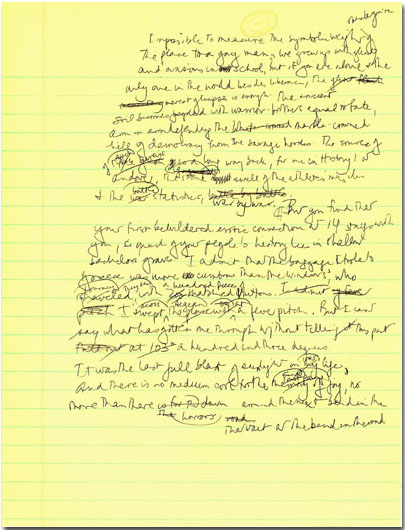
The department holds LGBT Studies materials in all collecting areas described in the department guide and in this exhibit, from incunabula to lesbian pulp fiction; from the first "gay study" in English (1883) to paperback popular psychology. In addition to printed materials there are personal papers and oral histories.
The material enhances the Department's holdings of importance in the social and cultural history of Los Angeles, to include interrelated materials of persons from ethnic, racial, and other minorities.
Collections from LGBT persons place their actions and creativity with other Los Angeles history and indicate how LGBT persons themselves created the context for other events and social change, particularly during the early years of liberation.
| Grecian
Guild Pictorial. v.1 no.2 (1955 Winter). To be added "Body building" magazines began about 1908 with Physical Culture, a publication of Bernarr Macfadden. There were others, but by the 1940s and 1950s they were still masking themselves with titles such as Adonis, Apollo, Grecian Guild Pictorial. This issue even carries an article on Greek sculpture, copying texts such as those of Victorians J. A. Symonds and Walter Pater, who had written about Greek art and wrestling - Pater about 1894 in his essay "The Age of Athletic Prizemen: A Chapter in Greek Art." The naïve text in this magazine relates: "The Grecian love of physical perfection was the natural companion to their perfection in art. It expressed itself in physical culture and athletic contests ... to them the male physique at its best was among the most sublime forms of beauty." The cover photo is of Steven Wengryn, once termed the "Liberace of physique models." Magazines such as this are beginning to be collected by libraries. Paul Monette had copies of these, although not transferred with his papers to UCLA. |  |
Paul Monette. Borrowed Time. First draft. 1987? 404 leaves total. Typescript and holograph. 2 selected leaves [scanned copy enlarged and scanned copy original size]. Published as and also shown, Borrowed Time: An AIDS Memoir. San Diego, New York, London: Harcourt Brace Jovanovich, c1988, cf. pages 20 - 23. In: Monette, Paul. Papers, 1945 - 1995. Collection 1707. Box. 17 f.42
 |
Shown at left is a leaf from the beginning of the first typescript of this work about
the death of his lover Roger Horwitz from AIDS. The two travel to Greece,
with a stay in Athens, then a visit to Delphi and to Crete, Santorini, Mykonos,
and Delos. Monette wrote of this time stolen from the disease: "This was the
last full blast of sunlight in our life."
This is but one of thousands of examples of complete manuscripts of literary works held by the Dept., enabling researchers to study the work from conception to publication, and in this case to see the author's mind at work. |
| Shown at right is a page which was together with the first draft typescript, an added holograph leaf in which Monette suddenly discovers and states a major idea of this section: "Impossible to measure the symbolic weight of the place [Greece] to a gay man." Later in this section he elaborates: "But a gay man seeks his history in mythic fragments, random as blocks of stone in the ruins covered in Greek characters ...." He alludes to the fragments of meaning for lesbian women: "We have the poems of Sappho because the one rolled linen copy stoppered a wine jug in a cave and the blanks are the words the acid of the wine has eaten away. Fragments are all you get." |  |
Sappho.The Songs of Sappho. In English translation by many poets; decorated by Paul McPharlin. Mount Vernon, NY: Peter Pauper Press, 1948? Special Collections SRLF
M. E. Kerr. We Walk Alone: a Gold Medal original by Ann Aldrich; cover painting by Jack Floherty, Jr. Greenwich, Conn.: Fawcett, c1955. Gold Medal book 509. Full cover title: We Walk Alone Through Lesbos's Lonely Groves. SCB 137311
Sidney Abbott and Barbara Love. Sappho Was a Right On Woman: A Liberated View of Lesbianism. New York: Stein and Day Publishers, c1972. Third printing 1974. In: Schreck, Frank E. Collection of material about homosexuality, 1968 - 1981. Collection 2083 Box 7
This cover shows a liberated lesbian whose depiction is not designed to attract male readers, as had been the case before.
[Lesbian and Gay community buttons] In: Kight, Morris. Papers, 1975 - 1993. Collection 354. Items to be added
Imagery and colors are primarily from the 1980s and 1990s using lavender and shades of pink and purple as positive symbols for the community, whereas in the past such usage might be derogatory, such as the phrase "lavender men." Other similarly derogatory terms, like "dyke," are reclaimed for slogans such as "Dyke - O - Rama." These slogans are variations on coming out of the closet or political send offs of the military such as "The Few, The Proud, The Gay." One button is a more serious quote from African American lesbian poet Audré Lorde: "Your silence will not save you."
Activist and collector Morris Kight has spent much of his life in the causes of gay liberation. He and others founded the Los Angeles Gay and Lesbian Center in 1971, now the largest of its kind in the world.
Gay activist Harry Hay, who began his political work before Kight, was the first openly gay person to be interviewed by the UCLA Oral History Program.
 |
References |  |

